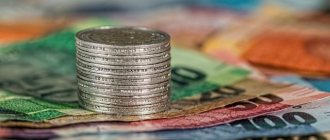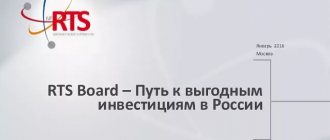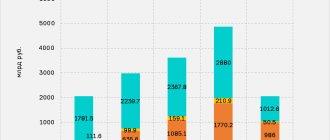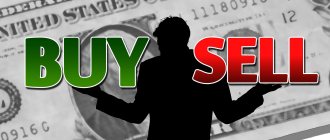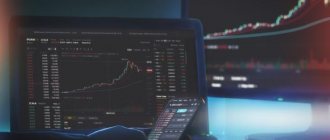Materials on the topic “Foreign exchange market”
Address for questions and suggestions about the site: [email protected]
Copyright © 2008–2021. LLC "Company BKS" Moscow, Prospekt Mira, 69, building 1 All rights reserved. Any use of site materials without permission is prohibited. License for brokerage activities No. 154-04434-100000, issued by the Federal Commission for the Securities Market of the Russian Federation on January 10, 2001.
The data is exchange information, the owner (owner) of which is PJSC Moscow Exchange. Distribution, broadcast or other provision of exchange information to third parties is possible only in the manner and under the conditions provided for by the procedure for using exchange information provided by Moscow Exchange OJSC. Brokercreditservice Company LLC, license No. 154-04434-100000 dated January 10, 2001 for brokerage activities. Issued by the Federal Financial Markets Service. No expiration date.
* The materials presented in this section do not constitute individual investment recommendations. The financial instruments or transactions mentioned in this section may not be suitable for you and may not correspond to your investment profile, financial situation, investment experience, knowledge, investment objectives, risk appetite and return. Determining the suitability of a financial instrument or transaction for investment objectives, investment horizon and risk tolerance is the responsibility of the investor. BKS Company LLC is not responsible for possible losses of the investor in the event of transactions or investing in financial instruments mentioned in this section.
The information cannot be considered a public offer, an offer or an invitation to purchase or sell any securities or other financial instruments, or to make transactions with them. The information cannot be considered as guarantees or promises of future investment returns, risk levels, costs, or break-even of investments. Past investment performance does not determine future returns. This is not an advertisement of securities. Before making an investment decision, the Investor must independently assess the economic risks and benefits, tax, legal, and accounting consequences of entering into a transaction, his readiness and ability to accept such risks. The client also bears the costs of paying for brokerage and depositary services, submitting orders by telephone, and other expenses payable by the client. The full list of tariffs of BCS Company LLC is given in Appendix No. 11 to the Regulations for the provision of services on the securities market of BCS Company LLC. Before making transactions, you also need to familiarize yourself with: notice of risks associated with transactions on the securities market; information about the client’s risks associated with making transactions with incomplete coverage, the occurrence of uncovered positions, temporarily uncovered positions; a statement disclosing the risks associated with conducting transactions in the market for futures contracts, forward contracts and options; declaration of risks associated with the acquisition of foreign securities.
The information and opinions provided are based on public sources that are recognized as reliable, however, BKS Company LLC is not responsible for the accuracy of the information provided. The information and opinions provided are formed by various experts, including independent ones, and opinions on the same situation can differ radically even among BCS experts. Given the foregoing, you should not rely solely on the materials presented at the expense of conducting independent analysis. BKS Company LLC and its affiliates and employees are not responsible for the use of this information, for direct or indirect damage resulting from the use of this information, as well as for its accuracy.
The story of two dollars
Back in 1976, American and Canadian dollars were exchanged at an almost one-to-one rate.
But over the following decades, the value of the Canadian dollar compared to its American counterpart steadily declined. As a result, in 1998, the Canadian dollar was already worth only about 65 American cents. The depreciation of the Canadian dollar intensified in the late 1990s, when world prices for many of Canada's primary exports fell sharply. Canadian manufacturing exporters rejoiced at the opportunity to sell their goods abroad, while importers complained about having to pay higher prices for imported goods. The consequences of this event affected thousands of people crossing the Canada-US border in both directions every day. Canadians, accustomed to traveling to the United States on weekends and dining at local restaurants, suddenly found that this pleasure now costs them much more. At the same time, Americans began to have difficulty finding partners for business negotiations in Canada.
The one Canadian dollar coin features on its reverse an image of a loon, a waterfowl that can often be seen on the rivers and lakes of Canada. Therefore, Canadian dollars are often called “loons”. But other Canadian birds, the Toronto Blue Jays, were among the first to abandon the use of loons in their internal calculations.
Because American Baseball League teams play south of the Canadian border and supply players to the American baseball market, 80% of their budget (including player salaries) is calculated in US dollars. But on the other hand, 80% of their income (including income from game tickets) goes to the team in Canadian dollars.
The sudden decline in the value of the loons resulted in large losses for the team due to a drop in its income relative to its expenses. To protect itself from the unpredictable behavior of the loons in the foreign exchange market, the team tries to anticipate and meet its US dollar needs by purchasing US currency in advance. After all, mistakes in the foreign exchange market can cost the Jays more than mistakes on the playing field.
American currency session opening hours
Work on the American continent does not coincide with our regime. After all, when it’s morning in Moscow, Americans, as a rule, sleep soundly.
The American trading session runs from 16:00 to 24:00 Moscow time. The continent is switching to daylight saving time, so adjust your operating hours.
Features of trading during the American trading session
A day trading session, although it would be more correct to call it a daily session, consists of 3 stages:
- fairly calm Asian trading session, when price adjustment occurs;
- active European session. Moreover, the peak occurs at 10–13 hours Moscow time: London comes into play;
- American session. The opening of the New York Stock Exchange coincides with the second half of the working day in Europe.
American trading session at this time:
- aggressive banks, hedge funds and other major investment firms;
- European currencies, securities and derivatives are actively traded.
When the European session closes, trading in the American session continues. The market is becoming “thin”, demand is decreasing. Therefore, significant movements in quotes (strong impulses) are possible.
Time differences in the operation of the main sites
In the American trading session, there is a one-hour break at the beginning of the exchanges. At 16:00 (Moscow time) New York opens (all exchanges absorbed by the NYSE). An hour later (at 17:00 Moscow time) Chicago (CME Group) starts working.
In Canada, the opening hours of the Toronto Stock Exchange are 17:30–22:00 (main session). After-sales session – from 22:15 to 01:00 (time taking into account the difference with Moscow +8 hours).
The stock exchange in Mexico opens at 17:30 (the difference with Moscow is +9 hours) and closes at 24:00. The debt market starts and closes half an hour earlier (17:00–23:30).
Exchange comparison table
American exchanges, absorbing each other, eventually became monopolists. The presence of small independent exchanges is only the appearance of free trade. Even if the historical name has been preserved on the sign, trading today takes place according to changed rules. And this must be taken into account if you want to become a trader.
| Exchange type | Major exchanges | conclusions |
| Stock | NASDAQ, CME Group, NYSE | The presence of websites for each division creates the illusion of competition and independence of a couple of dozen trading houses. In reality, the market is divided between 3 American giants. |
| Commodities (and derivatives) | NASDAQ, CME Group, NYSE | |
| Alternative trading platforms | BATS | The trading platform is owned by CBOE (Holdings owns 4 other exchanges). We have to state the fact: there is no alternative. |
| OTC market | OTCBB, OTC | Attempts to be controlled by the US government through FINRA, so be aware of congressional amendments when trading this trading market. |
How to start trading on American stock exchanges
Only a registered participant - a licensed broker - can trade on the American stock exchange. Choose those who comply with FCA requirements.
Through a Russian broker
If the amount of assets is less than $10,000, it is more profitable to trade on the American market through a Russian broker:
- exit through a single brokerage account. AMEX, NASDAQ, NYSE become available. You can only buy and sell shares that are traded on the St. Petersburg Stock Exchange. In this case, it is desirable to have the status of a qualified investor (higher education in economics, 2-3 years of experience in working with securities and at least 6 million rubles);
- exit through Cypriot subsidiaries (Finam, BCS). They will open a trading sub-brokerage account (but you will have to deal with the tax troubles yourself);
- a trust management agreement is used, where the form of management provides for the execution of trading orders for securities.
Reliable Russian brokers
| Name | Rating | pros | Minuses |
| Finam | 8/10 | The most reliable | Commissions |
| Opening | 7/10 | Low commissions | Imposing services |
| BKS | 7/10 | The most technologically advanced | Imposing services |
| Kit-Finance | 6.5/10 | Low commissions | Outdated software and user interface |
Foreign brokers
Working with a foreign broker is possible if you have permission to purchase securities issued by the Bank of Russia. It is beneficial when there is a free amount of more than $10,000.
After concluding an agreement with an American broker, the brokerage account is replenished. To start trading you need:
- exchange rubles for dollars with a spread;
- spend money when transferring (commission 2–5% and higher);
- pay a commission for each trading contract (for example, for S&P 500 futures, the commission is $7 per trade).
With a conditional $1000, the losses at the beginning of trading are already 50–100. Therefore, before signing the contract, I recommend calculating the total financial costs. It may turn out that it is profitable to buy shares through a Russian broker, not an American one.
Verified foreign brokers
| Name | Rating | pros | Minuses |
| Interactive Brokers | 8/10 | They speak Russian | Subscription fee 10$\month |
| CapTrader | 8/10 | No monthly fee | They only speak English |
| Lightspeed | 7/10 | Low minimum deposit | Imposing services |
| TD Ameritrade | 6.5/10 | Low commissions | Not everyone gets an account |
Warning about Forex and BO
Expert opinion
Vladimir Silchenko
Private investor, stock market expert and author of the Capitalist blog
Ask a Question
I warn novice financiers: Forex is an over-the-counter foreign exchange market, where the rate is formed based on the indicators of several trading platforms.
So slippage/lag is normal (but unpleasant). This is what trading platforms take advantage of. As soon as you start earning money, the price of currency pairs begins a strange dance. No analysis, advisor, or strategy will work in the long term.
Binary options are another type of game disguised as a foreign exchange trading market. The rate between the broker and the participant.
Quotes are drawn by the trading platform program - what a win we can talk about! If you want to become real investors, skip BO (attention: trading platforms disguise binary options as Fix-Contracts).
BATS Global Markets
BATS Global Markets is the third largest US exchange holding company by capitalization with an emphasis on innovative services. Since 2017 is part of CBOE Global Markets. BATS is present in the USA, Singapore and the UK. Operates four US stock exchanges, two US stock options exchanges, a pan-European stock market and a global market for trading foreign exchange products.
The company was founded in 2005. in Kansas City, Missouri. This happened at a time when the two largest US stock operators (NYSE Euronext and NASDAQ OMX Group) carved out a niche of 90% of the US market and increased prices for their clients. Since its founding, the company has positioned itself as a private exchange offering companies more favorable listing conditions. And this technique worked. The company began to grow rapidly, and the exchange's trading turnover began to increase significantly.
BATS was founded by programmer and software developer D. Cummings. It is not surprising that the advantages of the new trading platform were not only more favorable price conditions compared to the current monopolists, but also a convenient, well-thought-out service using information technology.
The focus of trading on electronic services and the use of advanced electronic trading services provide an operational advantage for the company. The company's costs are more than 10 times lower compared to key competitors NASDAQ and NYSE. Another distinctive feature of BATS Global Markets from other classic stock exchanges is the absence of listing requirements.
The exchange market capitalization is 5.4% of the global figure. The share of trading on this exchange is 10-12% of the total daily trading volume in the United States. The exchange controls about a quarter of the shares of the European and American markets and about 10% of the US options market. The exchange calculates the BATS 1000 index.
Company website: https://markets.cboe.com/
Risks when trading
It doesn’t matter whether it’s the foreign exchange market, the credit market or many of its other varieties, all the same, any financial transactions will be accompanied by great risks. And on the website of any broker that a trader is going to choose or has already chosen, it will be indicated that when making transactions on the foreign exchange market, there is a risk of loss of capital.
This is almost impossible to avoid. Risks of various types will still occur, and the main thing is to be able to cope with them. This is necessary for successful transactions. The peculiarity of the market is that it almost always goes against the trader, which leads to a significant reduction in the balance in his account.
Rate jumps
In order to prevent unnecessary losses of your funds due to changes in the exchange rate, you need to install the “Stop Loss” function. The principle of its operation is that the transaction is closed by the broker even if the trader is not online at the time if the price reaches a certain level. Traders very often have to face financial losses when they are unable to be at the computer during a transaction. “Stop Loss” can be launched even while opening a position. After all, sharp price fluctuations can appear in the market at any time.
“Stop Loss” - translated from English as “stop losses”. This order is placed in order to limit the loss of funds in the event of negative developments (loss limitation).
The emergence of panic
Psychological risks are constant companions of every modern newbie trader. The first feeling of panic appears after he sees a negative balance on the account after paying the fee. At the same time, a person begins to make mistakes under the influence of his emotions. When trading in the foreign exchange market, it is important to understand that it involves a large number of people who influence each other. At the same time, it is important to understand that you should not act as the majority does. To make a profit, it is important to first analyze the situation and then make a decision.
Non-market risk
There are a large number of situations when a trader may face the loss of his funds not because of the market situation. Sometimes a technical glitch occurs after a person has entered into a trade, but he has not yet managed to enable Stop Loss. As a result of a power outage or problems with the Internet, the trader was cut off from the network. As a result, after everything has worked out, he learns from the news that the market has gone against him. It turned out that he lost his deposit. It is precisely such reasons, independent of the market, that are called non-market.
The essence of monetary policy
State and market regulation of currencies complement each other: during crisis shocks, wars, post-war devastation, state regulation of currencies prevails, and when the monetary and economic situation is established, foreign exchange transactions are liberalized, market competition in this area is encouraged, but the state retains control over the currency for supervision and regulation currency relations.
In regulating a market economy, currency policy, which is a set of measures in the field of international monetary relations, carried out in accordance with the current and strategic goals of the country, is of particular importance.
Monetary policy is divided into:
- Structural monetary policy, i.e. a set of activities that are aimed at carrying out structural changes in the world monetary system. The implementation of this policy takes place in the form of currency reforms in order to improve its principles in the interests of all states.
- Current foreign exchange policy is a set of short-term measures aimed at the operational, day-to-day regulation of exchange rates, foreign exchange transactions, activities in the foreign exchange market and the gold market.
Finished works on a similar topic
- Coursework Foreign exchange market in Russia 470 rub.
- Abstract Foreign exchange market in Russia 240 rubles.
- Test work Foreign exchange market in Russia 230 rubles.
Receive completed work or advice from a specialist on your educational project Find out the cost
Note 1
The main objective of monetary policy is to ensure sustainable economic growth, curb inflation and unemployment, and maintain balance in the balance of payments.
Monetary policy can take several forms (Figure 1). Let's take a closer look at each of them.
Figure 1. Forms of monetary policy. Author24 - online exchange of student work
Discount policy is a form of foreign exchange policy that is based on changing the Central Bank discount rate to regulate the balance of payments and exchange rate by influencing global capital flows, as well as the dynamics of loans within the country, the dynamics of the money supply, aggregate demand and prices. In modern economic conditions, the effectiveness of the discount policy is reduced, since when interest rates fall, there is an outflow of capital, which negatively affects the balance of payments.
Are you a student at any Russian university? We invite you to a paid interview! The topic of the interview is preparation for the session and problems that arise during this Find out more
The motto policy is a form of foreign exchange policy in which the establishment of the national currency exchange rate occurs under the influence of the state’s purchase and sale of foreign currency, i.e. mottos. The monetary policy has a direct impact on the exchange rate, but to a limited extent and temporarily.
When diversifying foreign exchange reserves, the structure of foreign exchange reserves is regulated by including different types of currencies in their composition to ensure international payments, conduct foreign exchange intervention and protect against foreign exchange losses. Foreign exchange reserves are diversified by selling unstable currencies and purchasing the most stable ones.
Currency regulation is carried out through state regulation of the conditions of global settlements and stages of transactions with currency.
Foreign exchange restrictions are also one of the forms of foreign exchange policy, which include administrative or legislative prohibition, regulation of the actions of residents and non-residents, restrictions, etc.
